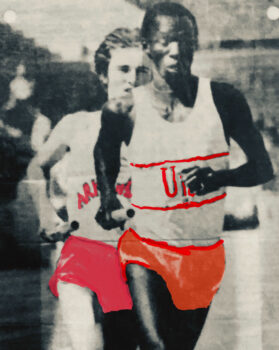History

John McDonnell was himself a distance runner. He was a 4.10 miler and an Irish champion 6 times in the mile, three-mile and steeplechase. He represented Ireland twice in the World Cross Country Championships and while on an athletic scholarship at the University of Southwest Louisiana (USL) beat the sensational Jim Ryun over 2 miles. He arrived in Fayetteville in 1972 as the University of Arkansas’s new cross country and distance coach. His plan was simple: recruit the best talent, work them hard and keep them challenged. In contrast, his goal was anything but simple. He intended to conquer the world of college distance running. However, before you can consider national dominance, you have to excel at the conference level. The year before, 1971, the University had finished last in the Southwest Conference (SWC) Cross Country Championships and that same academic year, the track team scored one point in the SWC outdoor meet.
In his first year, the Hogs finished almost 100 points behind Texas in the conference cross country. That same year in Sweden, Suleiman Nyambui, who years later would loom large over college running, ran the 10th fastest time in the world over two miles with a time of 8.27.47. In John’s second year, they narrowed the gap to 10 points, and in his third they were victorious. It had taken 3 years to go from obscurity to relevance. In the following 34 years of coaching, the Hogs would never lose a conference cross country championship and remarkably would go on to win 11 NCAA team titles.

John was ambitious and could see that a dominant distance running program was the ticket to success. His first recruiting class included Niall O’Shaughnessy, a half miler from Ireland who established a familiar pattern of milers excelling at both cross country and track. John expected a lot of his early stars and loaded them up with responsibility at conference. Niall started a tradition at Arkansas of running four events on the same day at the indoor conference meet – mile prelims, DMR anchor, mile final and 4 x 800m relay anchor. A feat that was repeated by others for a number years until the load could be shared. With his distance runners winning conference titles and making a significant impact on the track, John was named head track coach in 1977. He wasted no time justifying that choice, winning his first conference indoor championships in 1979, his second year as head coach. Notably, 8 of the 10 Razorbacks who scored that day were part of the distance team and senior Mike Clark did the same day quadruple that O’Shaughnessy had first done the previous year.
John knew he could not win an NCAA title with distance runners alone. The distance events were especially competitive at the NCAA level in the 70s and early 80s. There was no age restriction, and the strongest teams were stacked with older African runners like the 26-year-old and 1980 Olympic silver medalist Nyambui of Tanzania now a freshman at The University of Texas at El Paso (UTEP) and multi-world record holder Henry Rono of Kenya at Washington State University. UTEP was the powerhouse and was in the process of winning 10 consecutive NCAA team titles including 3 consecutive NCAA Triple Crowns. In Nyambui, they had an athlete who would become the most decorated star in NCAA history. During his 4 years as a Miner, he won 15 NCAA individual titles.

O’Mara at Texas
Nyambui tormented the Razorbacks. In cross country, he led the 1981 UTEP team to the NCAA title by almost 100 points over John’s young Razorback team who were runners up. The following year, Nyambui was beaten by his teammate Matthews Motshwarateu, the World Record holder over 10k on the road, but UTEP occupied 5 of the top 6 spots and narrowly missed a perfect score. John said at the time “ that was the greatest cross country team I have ever seen. They were out of this world”. The Hogs were 3rd this time. Even trips to the Texas Relays were perilous. Nyambui handed the Razorbacks a solid beating in both the 4 x 1 mile and distance medley relays. Arkansas was resolute, and John kept his teams motivated with victories at the Kansas and Drake Relays. Anyone could see they were closing the gap. Nyambui appreciated the Razorback grit. At his final NCAAs in 82, after he had won the 5000m and 10,000m for the fourth time in a commanding fashion, he found John in the stands. He reached out his hand and said, “Coach, Bui is gone, Arkansas will win now”. Ted Banks, the UTEP head coach, had retired and Bui, the team leader, was done.
There was the small matter of Southern Methodist University (SMU) to contend with. UTEP assistant coach, Ted McLaughlin, had taken the head coaching position at SMU and immediately built them into UTEP’s successor . SMU won the 1983 NCAA Indoor and Outdoor Championships with stars like Michael Carter, Olympic silver medalist the following year and Keith Connor, World Champion at the inaugural championships that summer in Helsinki. Turns out SMU was even more adept at violating NCAA rules, and their supremacy was short lived.

John kept pushing the team and raising the standard. Niall O’Shaughnessy, John’s first star had been competitive individually at the NCAA Championships. Three times he finished in the top 3 at Nationals. John’s second track recruiting class included Dave Taylor who, aided by Mark Andersen’s 8th place in 1980, led the Razorback cross teams to two top three national finishes with individual placings of 10th and 9th and roommates Randy Stephens and Frank O’Mara. The later two became John’s first individual national champions. Randy won the indoor 1000yds in 1982 and Frank, who was from the same high school as Niall O’Shaughnessy, won the outdoor 1500m in 83. The track team had taken its cue from their cross country counterparts and was knocking on the national title door placing second in Indoor Nationals in 1982 behind UTEP and third behind SMU in 1983. They confirmed their national aspirations with 3 victories against traditional east coast powerhouses at the 1983 Penn Relays in Philadelphia.

With individual success and the growing prowess of his track teams, John knew his team was on the brink of success. The key to unlocking the door turned out to be a high school basketball player from Chicago by the name of Mike Conley. Conley would lead the Razorbacks to their first NCAA team title the following year, and on the back of Conley’s 9 NCAA individual titles, the Hogs would win their first outdoor championship and NCAA triple crown in 1985. Just like Bui.

Strangely, the first title came in track and not cross country. Arkansas had built its reputation on the back of distance running but it was the combined effort of its distance runners and jumpers that blew the hinges off the door. Fittingly, the Fall of that same year the hogs won their first NCAA Cross Country title in State College, Pennsylvania. John was ecstatic; he had finally delivered on his original goal. It had taken 12 years but he had conquered the college distance running world. More importantly, the Hogs had persevered through 5 top three placings before their first title. This would only serve to harden them for future campaigns. John and the Razorbacks would go on to dominate college track in a manner that nobody, including Bui could have foreseen.
